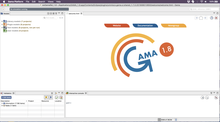GAMA[3][4] (GIS Agent-based Modeling Architecture) is a simulation platform with a complete modelling and simulation integrated development environment (IDE) for writing and experimenting spatially explicit agent-based models.[5][6]
 | |
 Screenshot from the GAMA Platform 1.8.0 | |
| Developer(s) | IRD |
|---|---|
| Initial release | October 2009.[1] |
| Stable release | 1.9.1
/ April 25, 2023[2] |
| Repository | https://github.com/gama-platform/gama |
| Written in | Java |
| Operating system | Windows, macOS, Linux |
| Platform | x86-64 |
| Size | 100 ~ 275 MB |
| Available in | English |
| License | GPL3 |
| Website | http://gama-platform.org |
About
editThe GAMA Platform is agent-based modeling software that was originally (2007-2010) developed by the Vietnamese-French research team MSI (located at IFI, Hanoi, and part of the IRD - SU International Research Unit UMMISCO). It is now developed by an international consortium of academic and industrial partners led by UMMISCO Archived 2022-01-23 at the Wayback Machine, including INRAE, the University of Toulouse 1, the University of Rouen, the University of Orsay, the University of Can Tho, Vietnam, the National University of Hanoi, EDF R&D, CEA LISC, and MIT Media Lab.[6]
GAMA was designed to allow domain experts without a programming background to model phenomena from their field of expertise.[7]
The GAMA environment enables exploration of emergent phenomena. It comes with a models library including examples from several domains, such as economics, biology, physics, chemistry, psychology, and system dynamics.[8] The GAMA simulation panel allows exploration by modifying switches, sliders, choosers, inputs, and other user interface elements that the modeler chooses to make available.[9]
Technical foundation
editGAMA Platform is free and open-source software, released under a GNU General Public License (GPL3).[10] It is written in Java and runs on the Java virtual machine (JVM).[11] All core components and extensions are written in Java, but end users do not need to work in Java at all if they use a published build of the platform; instead, they would write all models using GAML (described below).
Multiple application domains
editGAMA was developed with a very general approach and can be used for many application domains.[5] GAMA is mostly present in applications domains like transport,[12][13][14][15][16] urban planning,[14][15][16] disaster response,[17] epidemiology,[18][19][20] analysis of multirobot systems,[21][22] and the environment,[14][15][16] with special emphasis on analyses that use GIS data.[23][24]
High-level Agent-based language
editGAML (GAma Modeling Language) is the dedicated language used in GAMA. It is an agent-based language, that provides the possibility to build a model with several paradigms of modeling.[5]
This high-level language was inspired by Smalltalk and Java, GAMA has been developed to be used by non-computer scientists.[5]
User interface
editModelers may use many visual representations for the same model, in order to highlight a certain aspect of a simulation. These include 2D/3D displays, with basic control of lighting, textures, and cameras. Standard charts such as series plots may also be constructed.[5]
Project examples
editThe developers maintain a community-sourced list of scientific projects that use GAMA.[25]
Some of the larger efforts include:
- Hoan Kiem Air:[14] Agent based modeling and simulation of the urban management on traffic and air pollution through tangible interface.
- Proxymix:[26] Visualization tool about the influence of spatial configuration on human collaboration.
- CityScope Champs-Elysées:[15] An interactive platform to improve decision-making related to the revitalization of the Champs Élysées.
- ESCAPE:[16] A Multi-modal Urban Traffic Agent-Based Framework to Study Individual Response to Catastrophic Events.
- COMOKIT:[19][20] Generic model of public policies to contain the spread of COVID-19 epidemics in a city, validated on the basis of different case studies.
Users
editSeveral academic institutions teach modeling and simulation courses based on GAMA. It is taught in the Urban Simulation class at the Potsdam University of Applied Sciences,[27] and at the University of Salzburg.[28] It is also used and taught annually at the Multi-platform International Summer School on Agent-Based Modelling & Simulation.[29]
See also
editReferences
edit- ^ "GAMA 1.1". GAMA Documentation.
- ^ "Home of GAMA development". Github.
- ^ Taillandier, Patrick; Gaudou, Benoit; Grignard, Arnaud; Huynh, Quang-Nghi; Marilleau, Nicolas; Caillou, Philippe; Philippon, Damien; Drogoul, Alexis (April 2019). "Building, composing and experimenting complex spatial models with the GAMA platform" (PDF). GeoInformatica. 23 (2). Springer US: 299–322. doi:10.1007/s10707-018-00339-6. ISSN 1573-7624. S2CID 134137907.
- ^ Grignard, Arnaud; Taillandier, Patrick; Gaudou, Benoit; Vo, Duc An; Huynh, Quand-Nghi; Drogoul, Alexis (2013). "GAMA 1.6: Advancing the Art of Complex Agent-Based Modeling and Simulation" (PDF). PRIMA 2013: Principles and Practice of Multi-Agent Systems. Lecture Notes in Computer Science. Vol. 8291. Springer. pp. 117–131. doi:10.1007/978-3-642-44927-7_9. ISBN 978-3-642-44926-0.
- ^ a b c d e "GAMA · GAMA-Platform". gama-platform.github.io. Retrieved 1 November 2019. Material was copied from this source, which is available under a Creative Commons Attribution 4.0 International License.
- ^ a b "Introduction · GAMA-Platform". gama-platform.github.io. Retrieved 1 November 2019. Material was copied from this source, which is available under a Creative Commons Attribution 4.0 International License.
- ^ Taillandier, Patrick; Gaudou, Benoit; Grignard, Arnaud; Huynh, Quang-Nghi; Marilleau, Nicolas; Caillou, Philippe; Philippon, Damien; Drogoul, Alexis (December 23, 2018), "Building, Composing and Experimenting Complex Spatial Models with the GAMA Platform" (PDF), GeoInformatica, 23 (2): 299–322, doi:10.1007/s10707-018-00339-6, S2CID 134137907
- ^ "Tutorials". GAMA-Platform. Retrieved 2019-10-30.
- ^ "Controls of experiments". GAMA-Platform. Retrieved 2019-10-30.
- ^ "gama/LICENSE at master - gama-platform/gama". Github. 29 April 2020.
- ^ "Architecture of GAMA". GAMA-Platform.
- ^ Kaziyeva, Dana; Wallentin, Gudrun; Loidl, Martin; Mohr, Stefan; Neuwirth, Christian (2018). "Reviewing Software for Agent-based Bicycle Flow Models". GI Forum. 6.
- ^ Hutzler, Guillaume; Klaudel, Hanna; Sali, Abderrahmane (2020). "Filtering Distributed Information to Build a Plausible Scene for Autonomous and Connected Vehicles". 17th International Conference on Distributed Computing and Artificial Intelligence.
- ^ a b c d "WARMTeam/HoanKiemAir". Github. Hanoi, Vietnam: WARM Team. Retrieved 2019-10-30.
- ^ a b c d "CityScope Champs_Elysées: An interactive platform to improve decision-making related to the revitalization of the Champs Élysées". MIT Media Lab. MIT. Retrieved 2020-03-30.
- ^ a b c d Chapuis, Kevin; Taillandier, Patrick; Gaudou, Benoit; Drogoul, Alexis; Daudé, Eric (2018), "A Multi-modal Urban Traffic Agent-Based Framework to Study Individual Response to Catastrophic Events", PRIMA 2018: Principles and Practice of Multi-Agent Systems (PDF), Lecture Notes in Computer Science, vol. 11224, Springer, Cham (published 24 October 2018), pp. 440–448, doi:10.1007/978-3-030-03098-8_28, ISBN 978-3-030-03097-1, S2CID 53084730
- ^ Alonso Vicario, S; Mazzoleni, M; Bhamidipati, S; Gharesifard, M; Ridolfi, E; Pandolfo, C; Alfonso, L (2020). "Unraveling the influence of human behaviour on reducing casualties during flood evacuation". Hydrological Sciences Journal. 65 (14): 2359–2375. doi:10.1080/02626667.2020.1810254. hdl:11573/1626577.
- ^ Jindal, Akshay (2017). "Agent-Based Modeling and Simulation of Mosquito-Borne Disease Transmission". Proceedings of the 16th International Conference on Autonomous Agents and Multiagent Systems (AAMAS 2017).
- ^ a b "CoViD19". gama-platform.github.io. GAMA Team. Archived from the original on 2020-05-02. Retrieved 2020-02-15.
- ^ a b "COMOKIT". github.com. Hanoi, Vietnam: COMOKIT Team. Retrieved 2020-02-15.
- ^ Humann, James; Spero, Eric (2018). "Modeling and simulation of multi-UAV, multi-operator surveillance systems". 2018 Annual IEEE International Systems Conference (SysCon). pp. 1–8. doi:10.1109/SYSCON.2018.8369546. ISBN 978-1-5386-3664-0. S2CID 44133459.
- ^ Humann, James; Pollard, Kimberly (2019). "Human Factors in the Scalability of Multirobot Operation: A Review and Simulation". 2019 IEEE International Conference on Systems, Man and Cybernetics (SMC). pp. 700–707. doi:10.1109/SMC.2019.8913876. ISBN 978-1-7281-4569-3. S2CID 208630260.
- ^ Thierry, Hugo; Rogers, Haldre (2020). "Where to rewild? A conceptual framework to spatially optimize ecological function". Proceedings of the Royal Society B. 287 (1922). doi:10.1098/rspb.2019.3017. PMC 7126074. PMID 32126955.
- ^ Abar, Sameera; Theodoropoulos, Georgios K; Lemarinier, Pierre; O'Hare, Gregory (2017). "Agent Based Modelling and Simulation tools: A review of the state-of-art software". Computer Science Review. 24: 13–33. doi:10.1016/j.cosrev.2017.03.001.
- ^ "GAMA-platform References". gama-platform.github.io. Retrieved 18 August 2020.
- ^ "Proxymix: Influence of spatial configuration on human collaboration". MIT Media Lab. MIT. Retrieved 2019-10-30.
- ^ Szczepanska, Timo; Priebe, Max; Schroder, Tobias (2020). Teaching the Complexity of Urban Systems with Participatory Social Simulation. Springer.
- ^ "UNIGIS Summer School Spatial Simulation Modelling".
- ^ "Multi-platform International Summer School on Agent-Based Modelling & Simulation for Renewable Resources Management".